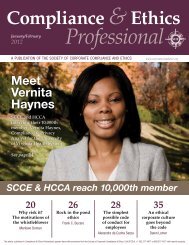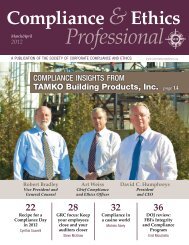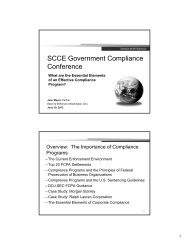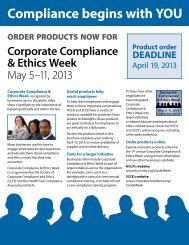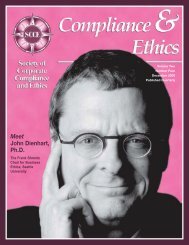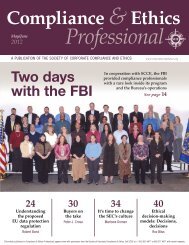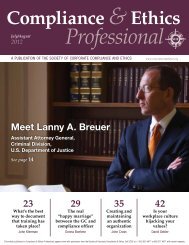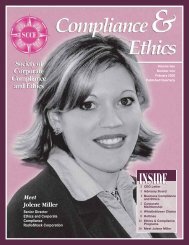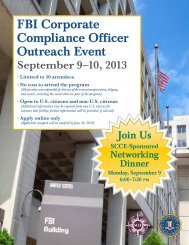Compliance &Ethics - Society of Corporate Compliance and Ethics
Compliance &Ethics - Society of Corporate Compliance and Ethics
Compliance &Ethics - Society of Corporate Compliance and Ethics
- No tags were found...
Create successful ePaper yourself
Turn your PDF publications into a flip-book with our unique Google optimized e-Paper software.
Featureby Mark DiamondSeven strategies for preventingusers from hoarding documents»»Employee hoarding <strong>of</strong> electronic documents is an information governance change management problem.»»Aggressive deletion <strong>of</strong>ten drives underground archiving, making the problem worse.»»Addressing underground archiving requires a cross-functional approach engaging policies, processes, tools, <strong>and</strong> technologies.»»Effective approaches create a “win” for employees by underst<strong>and</strong>ing the reasons for their behaviors.»»Ongoing auditing is critical to assess program effectiveness.DiamondHoarding <strong>of</strong> electronic information Many IT departments have found that justis a common problem that reduces devoting more storage to the problem is at bestemployee productivity, raises IT a temporary fix. It is true that the acquisition80% rate. 3 5% to 10% are deleters. Pilers tend to driveoperational expenses, <strong>and</strong> heightens the risks<strong>and</strong> costs <strong>of</strong> regulatory action <strong>and</strong> litigation.Organizations need to assert centralized control<strong>of</strong> deletion in order to overcomethe consequences <strong>of</strong> informationhoarding. But such efforts can runinto resistance from employees.Most organizations let informationpile up. New information is likesnow, <strong>and</strong> legacy collections <strong>of</strong> datacost—but not the operating cost—<strong>of</strong> storage istrending downward. And “the cloud” <strong>of</strong>fersmanageable costs <strong>and</strong> virtually unlimitedcapacity. Still, as the volume <strong>of</strong> informationgrows—<strong>and</strong> content repositories <strong>and</strong> managementsystems proliferate—problems crop up.Queries <strong>and</strong> searches can take longer, confidentialdata can fall into the wrong h<strong>and</strong>s, <strong>and</strong>considerable effort may required to respond toeDiscovery requests or regulatory challenges.are like glaciers: each year, layers areadded, some melt away, but the accumulationkeeps growing.Why hoarding is an end-user problemSome people are “filers.” They classify information··The size <strong>of</strong> the digital universe in 2012is estimated at 2.7 zettabytes (2.7 trilliongigabytes), <strong>and</strong> is forecast to be 40zettabytes by 2020—a 50-fold growth sincethe beginning <strong>of</strong> 2010. 1(most <strong>of</strong>ten manually), <strong>and</strong> rely onfolder-based navigation to find what theyneed. Other people are “pilers.” They saveall <strong>of</strong> their documents on the desktop, inthe email inbox, or wherever they originally··Businesses sent <strong>and</strong> received 89 billionemails per day in 2012, which should growto over 143 billion by year-end 2016. 2reside, delete almost nothing, <strong>and</strong> relyon search to find important information.“Deleters” get rid <strong>of</strong> information as soon as it’s··Unstructured data (e.g., files, <strong>of</strong>fice productivitydocuments, SharePoint, <strong>and</strong> otherinformation generated by applications)in the enterprise is growing at up to <strong>and</strong>etermined to be <strong>of</strong> no use to them.We find that more than 50% <strong>of</strong> employeesin organizations <strong>of</strong> all sizes are pilers. A somewhatsmaller percentage are filers, <strong>and</strong> from<strong>Compliance</strong> & <strong>Ethics</strong> Pr<strong>of</strong>essional May/June 2013+1 952 933 4977 or 888 277 4977 www.corporatecompliance.org 25




